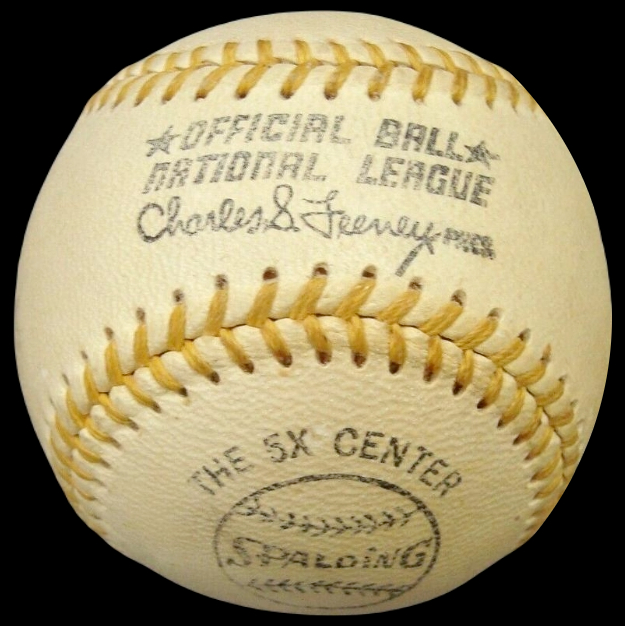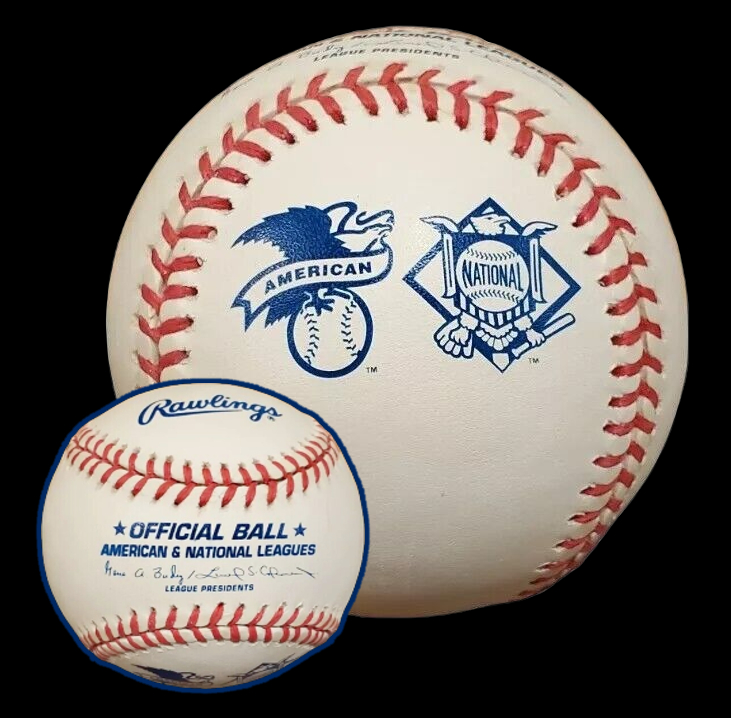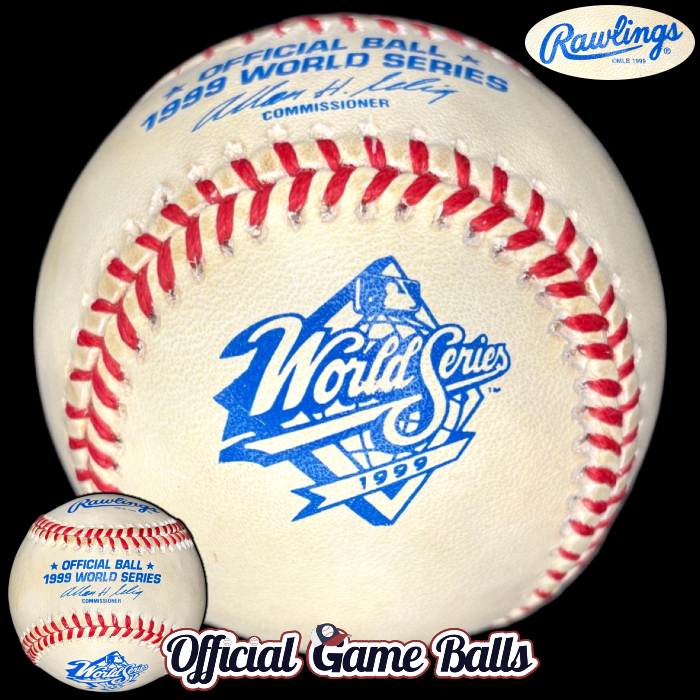Behold, OfficialGameBalls’ home for peculiar baseballs — The Museum of Baseballs MLB Misfits. A catch-call gallery for mostly Major League Prototypes, Samples, Test baseballs, and Misprints. Most of the baseballs pictured in this very special Museum of Baseballs gallery are official “prototypes” or test prints.
Rawlings has test-stamped endless variations of logos for MLB commemorative game balls. These are mostly used as sample balls to showcase different logo designs, fonts, font and logo sizes, or ink and lace color combos. And they’re mostly sent to MLB teams or folks at the commissioner’s office for approval or changes. And then there are more traditional prototypes for new products pitches, experiments, and baseball design modifications…
MLB Prototype Baseballs – Standard Game Balls
1930s Spalding National League Prototype. 1969 Spalding NL Canada Blue-Stamped (Giles). 1970-73* Spalding AL 5X Center (Cronin) X2. 1973-75* Spalding NL 5X Center (Feeney) Yellow-Laced. 1974-76* Spalding NL 5X Center (Feeney) Multicolor-Laced. 1975-76* Spalding NL Multicolor-Laced Unknown Use (Feeney). 1973* AL Reach by Spalding Orange Leather (Cronin) X2. 1973-74* AL Spalding Orange Leather (MacPhail) X2. Mid-1970s Spalding NL Star Logo Unknown Use (Feeney). 1973-75* Spalding AL Multicolor-Laced Unknown Use (MacPhail). 1980s Wilson NL & AL Prototypes (X2) (Bid for MLB contract). 1990-92 Rawlings AL Neon Yellow Night Game Metrodome Test Ball X2 Black Ink & Red Ink (Brown). 1997 Rawlings Interleague AL-NL Prototype ROMLB-RON/ROA (Coleman & Budig). 2020-22 MLB Tacky Surface Test Ball (Manfred). (*Estimated production years)





















Spalding, Reach, Rawlings and even Wilson have submitted officially stamped game-style baseballs to the league. Some are tested in exhibition games and trials to be considered for real on-field Major League Baseball game-use! Most of the prototypes below would have required a battery of tests and actual (exhibition) game play, and some are authenticated as such. Others likely never made it to those final stages and were repackaged or leaked out to dealers and Rawlings factory shops. Some come from the private collections of long-time Rawlings or MLB executives.
Sporting goods’ manufacturers have created many baseballs to experiment with colorful dyed leather, horsehide and cowhide alternatives, and design changes like pill, rubber, cork, and yarn alternatives. Read more about the 5X Center experiment (super-lively ball). Discover the varieties of infamous Charles O. Finley experimental orange balls. And check out those gorgeous multicolor-laced vintage AL & NL baseballs – some of which may have been official “commemorative” gamers used in MLB games and special events – so not just ‘tests or ‘prototypes’!
Rawlings MLB All-Star Game Prototypes, Samples, & Misprints Baseballs
It’s conceivable that every All-Star ball has a prototype, and likely many versions which would be better classified as “samples.” But how many of these variations have made their way to the public? More All-Star Game reprint misprints and errors can be found in the All-Star Game gallery, in the end in the modern reprint section. That’s more to help collectors spot differences between original on-field examples vs. modern reprint runs. This Prototype gallery is where the really fun and unusual prototype and test print examples will be located.
- 1979–2000 MLB ASG: 1979 Blue. 1979 Haiti 1-Dot (1981). 1980 Haiti 5-Dot. 1986 Red-Blue Laced. 1986 Red Stamped (possibly BP/Practice).
- 1992 Samples/Prototypes & Misprints: 1) Black-Laced / Black-Stamped, 2) Navy-Laced / Black-Stamped, 3) Navy-Laced / Navy-Stamped, 4) Black-Laced / Black-Stamped, 5) Orange-Laced / Black-Stamped, 6) Orange & Black-Laced / Black-Stamped, 7) Orange & Black-Laced / Navy-Stamped, 8) Orange & Navy-Laced / Black-Stamped, 9) 1990s Secondary Print Run Error Navy & Yellowish-Orange Laced / Blue-Stamped, 10) The 1992 ASG Official Game Ball😅.
- 1995 Multicolor Logo. 1997 No Commissioner Selig Signature. 2000 Red-Laced Primary ASG (Patch) Logo & Red Laced Old Pre-2000s Rawlings Logo (not visible).



















- 2001 Prototype Seattle Northwest Green (Teal) & Silver-Laced. 2001 Prototype Navy Blue & Silver-Laced. 2001 Misprint/Error Souvenir LogoBall Style Stamping—Missing “OFFICIAL BALL”. 2004 Black Ink Sample. 2007 Prototype Primary Logo (So much better!). 2007 Prototype Orange-Stamped Primary Logo (WOW!). 2008 Small Logo Sample.
- 2010s Reprint 1988 ASG Redesign/Refined Logo. 2010s Reprint 1991 ASG Error (Intentional?!) Red Stamped. 2010s Reprint 1994 ASG Error Inverted Logo. 2012 Prototype/Sample Dark & Medium Blue Laced (I miss this one!). 2014 Blue Ink Twins Logo Variant (Possibly just a visual mockup). 2014 Blue Stamped Sample. 2015 Selig Version Promotional/Logo Unveiling.














Rawlings MLB World Series Prototypes, Samples, & Misprints Baseballs
And it’s just as likely that every World Series baseball has “prototypes” or samples with designs variations too… Then there are more unusual sample prints for different ink colors or different logo designs, and a few multicolor logo attempts. Cool! Plus the modern reprint runs with their many flaws (these being the least appealing in my personal opinion).
We refer to these accidents on reprint runs as legitimate errors; common mistakes include stamping the modern Rawlings-R logo on an older ball that should have the pre-2000 era Rawlings logo (without the encircled “R” in the center). Sometimes errors are barely noticeable, like the addition trademark or copyright symbols (™ or ©) next to the commemorative logo on a reprint ball that didn’t exist (or at least wasn’t visible) on the original on-field official game ball. We highlight most of those less than glamorous reprints at the end of the MLB World Series Gallery. Let’s reserve this section of the prototypes gallery for the really cool stuff.

















Sometimes it’s just a simple, almost indiscernible logo size change, or a font style or size change. But the highly prized test print variations are usually quite different from their final approved ROMLB game ball and retail baseball. It’s been said that in the early years of the modern game ball commemoratives, Rawlings could take ages to select an ink stamp color for World Series and Midsummer Classic baseballs. That was probably the case before they settled on alternating red and blue for the first dozen or so years, from 1978 until 1991, when the Toronto Blue Jays broke that pattern with a blue-stamped All-Star Game ball. And in 1992, opportunities for prototypes exploded when our favorite baseball marketing exec made one little design request while with the San Diego Padres that would change the course of official game ball history for the Big Leagues and professional leagues around the world.
Rawlings MLB Commemorative Logo Special Event Game Ball Prototypes, Samples, Test Prints, & Misprints
It’s conceivable that every commemorative logo official game ball has at least one, if not several samples and/or test print variations. Plus, there is evidence of many proposed baseballs for special event that didn’t quite get approved and make it into gameplay. We’ve rounded up a couple examples for your viewing pleasure!
1990s–2000 NL, AL & MLB Prototypes, Samples, Test Prints, & Misprints




















2001–2025 Major League Baseball Prototypes, Samples, Test Prints, & Misprints























There are tons “prototypes” that are merely just samples to show minor print and logo adjustments. And there are also a few examples of genuine errors or misprints. As in real spelling errors, not just a print flaw or stamping mistake! See if you can spot those above (1 spoiler below).
So a few of these went from design phase, to management approval, to team or league inspection, and all the way to production, boxing and retail sales before they were ultimately pulled from store shelves and redesigned with a fix… if they even bothered to provide a fix. A few even made it into gameplay or were repurposed as BP/Practice balls or just for consumers.
Two infamous examples are the 1997 “Amercian League” ALDS Division Series and ALCS Championship Series baseballs. We’d guess there were hundreds of these two made that hit the market. Perhaps several thousand of each.
Most of these prototype and sample baseballs are extremely rare, however. Some examples in our collections are the only one we’ve seen. And they can be highly valued by obsessed official game ball collectors like us, who love finding something odd or unique—especially a ball with stamping color, logo design, or stitching that is significantly different than its common approved on-field and retail counterpart.
